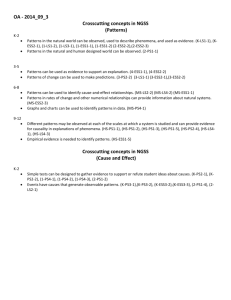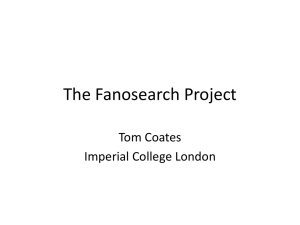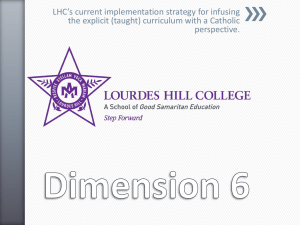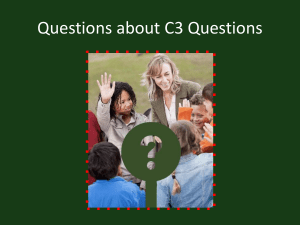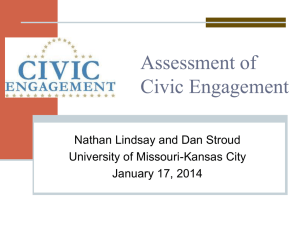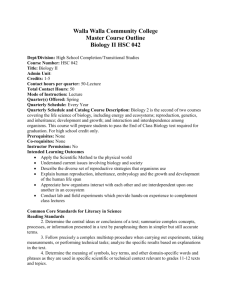C3 - Center for P
advertisement
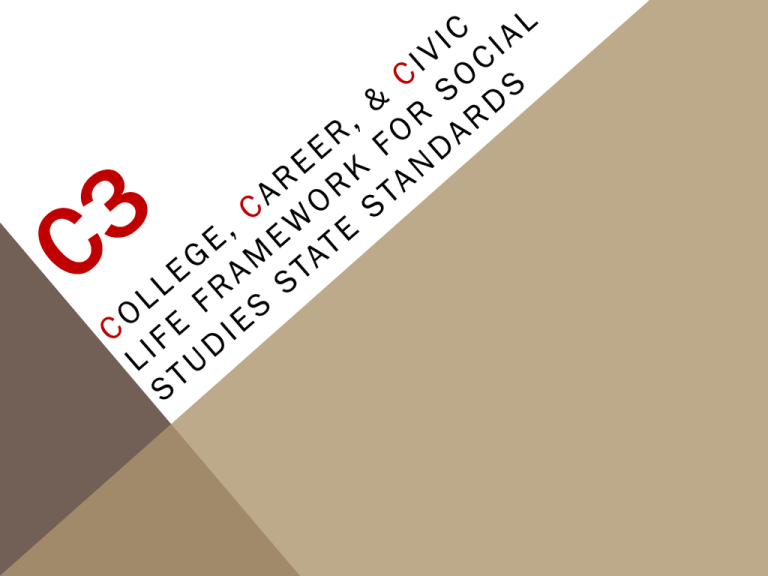
WHO? Collaboration between: Representatives from 23 states (including Illinois) 15 Professional Organizations (AHA, NCSS, NCGE, NCHE, American Bar Association . . .) Social Studies Teachers k-12 Experts in the Social Studies fields Might be the most extensive collaboration of social studies stake holders to collaborate on a project, ever! WHAT? C3 is a framework to complement state standards, not to replace state standards. Concept Content vs. Curricular Content C3 is not a set of curricular content standards. It does not give specific and comprehensive direction on the scope and sequence of social studies k-12 education Curricular Content will still be left to state and local education entities. There is “Conceptual Content” or big ideas Focus on 4 “core” social studies disciplines and how to teach more than what to teach. Concept rich rather than content rich More on the “What?” in a little while! WHEN? Work on the C3 started after the release of the Common Core Standards in 2010. After three years of collaboration and discussion the C3 framework was ready! Published on September 17, 2013. So, if you haven’t heard of the C3 yet, you aren’t alone! WHY? Collective response to Common Core Standards from social studies stake holders. Fear that social studies would be rolled in to English / Language Arts and not studied in its own right. Disciplines wide response to why social studies is important to study and what studying social studies does that studying other disciplines does not. “Literacy Through Social Studies”: Acknowledgement that teaching social studies is teaching literacy but that the value of social studies goes beyond just literacy and career/college preparation and into preparation for engagement in civic life. C3 IS THE COMMON CORE AND MORE! C3 aligns to, incorporates, and extends all 36 anchor standards from the ELA Common Core Foundational: All ELA / Literacy Common Core Standards Supportive: Reading 1-10; Writing 1, 7-9; Speaking and Listening 1-6; Language 6 Vital: Reading 1; Writing 7; Speaking and Listening 1. Vital Supportive Foundational COMMON CORE AND C3 SHARED LANGUAGE The authors of the C3 Framework intentionally used the same academic language that is utilized in the Common Core when discussing what students should be able to do with regards to social studies The good news - - The Common Core got it right! So using the same language was a natural fit! Dimension 1: Argument; Explanation; Point of View Dimension 2: Analysis; Argument; Evidence; Questioning Dimension 3: Argument; Sources; Evidence; Claims; Counterclaims Dimension 4: Argument; Explanation; Sources; Evidence; Claims; Counterclaims; Visualize; Credibility One important distinction: The Common Core uses the word “opinion” for K-5. The C3 Framework uses the word “argument” instead. THREE PILLARS OF THE C3 1. Inquiry is and should be the center of social studies education at all levels 2. Disciplinary integrity does matter but so to do interdisciplinary connections 3. Informed action (civic life) is clear and present as a part of social studies education. THE INQUIRY ARC Dimension 3 Evaluating Sources & Using Evidence Dimension 1: Developing Questions & Planning Inquiries DIMENSION 1: QUESTIONS Questioning is key to student learning. 2 kinds of questions Compelling Questions: (Lead to Arguments) Focus on real problems, issues, or curiosities. Intellectually rich and multi faceted with interdisciplinary answers. The kinds of questions scholars as well as citizens discuss and write about. Examples include: Was the American Revolution truly revolutionary? Should we build transcontinental oil pipelines? Supporting Questions: (Lead to Explanations) These questions scaffold learning and provide supporting information for the compelling questions More informational in nature Focus on descriptions, definitions, and processes They build the larger framework for student inquiry. DIMENSION 1 STEPS: 1. Construct Compelling Questions 2. Construct Supporting Questions 3. Determine Helpful sources DIMENSION 2: APPLYING DISCIPLINARY CONCEPTS AND TOOLS Focus on four “federally defined” core social studies areas: Civics Economics Geography History Behavioral sciences not included in C3 but each discipline (Anthropology, Psychology, and Sociology) submitted appendices to the C3 Framework that address who those fields contribute to a rich and varied social studies education. See Lesson Planning Packets for grade level specific standards in Civics, Economics, Geography, and History CONCEPTS OF THE CORE 4: Civics: Geography: Civic and Political Institutions Geographic Representations: Spatial Views of the World Participation and Deliberation Human-Environment Interaction: Place, Regions, and Culture Processes, Rules, and Laws Economics: Economic Decision Making Exchange and Markets The National Economy The Global Economy Human Population: Spatial Patterns and Movements Global Interconnections: Changing Spatial Patterns History: Change, Continuity, and Context Perspectives Historical Sources and Evidence Causation and Argumentation DIMENSION 3: EVALUATING SOURCES & USING EVIDENCE Table 25: Gathering and Evaluating Sources BY THE END OF GRADE 2 BY THE END OF GRADE 5 BY THE END OF GRADE 8 BY THE END OF GRADE 12 INDIVIDUALLY AND WITH OTHERS, STUDENTS… D3.1.K-2. Gather relevant information from one or two sourceswhileusingtheorigin and structure to guide the selection. D3.1.3-5. Gather relevant information from multiple sources whileusingtheorigin, structure, and context to guidetheselection. D3.1.6-8. Gather relevant information from multiple sources whileusingtheorigin, authority, structure, context, and corroborativevalueof the sources to guide the selection. D3.1.9-12. Gather relevant information from multiple sources representing a wide rangeof views while usingthe origin, authority, structure, context,and corroborative value of the sources to guide the selection. D3.2.K-2. Evaluatea source by distinguishing between fact and opinion. D3.2.3-5. Use distinctions among fact and opinion to determine the credibility of multiple sources. D3.2.6-8. Evaluate the credibility of a sourceby determiningits relevanceand intended use. D3.2.9-12. Evaluate the credibilityof a sourceby examining how experts value the source. DIMENSION 3: EVALUATING SOURCES & USING EVIDENCE Table 26: Developing Claims and Using Evidence BY THE END OF GRADE 2 BY THE END OF GRADE 5 BY THE END OF GRADE 8 BY THE END OF GRADE 12 INDIVIDUALLY AND WITH OTHERS, STUDENTS… Begins in grades 3–5 D3.3.3-5. Identify evidence that draws information from multiple sourcesin response to compelling questions. D3.3.6-8. Identify evidence that draws information from multiple sourcesto support claims, noting evidentiary limitations. D3.3.9-12. Identify evidence that draws informationdirectly and substantively from multiple sources to detect inconsistencies in evidencein order to revise or strengthen claims. Begins in grades 3–5 D3.4.3-5. Useevidence to develop claims in response to compelling questions. D3.4.6-8. Develop claims and counterclaims while pointing out the strengths and limitations of both. D3.4.9-12. Refine claims and counterclaimsattendingto precision, significance, and knowledge conveyed through the claim while pointing out the strengths and limitations of both. DIMENSION 4: COMMUNICATING CONCLUSIONS AND TAKING INFORMED ACTION! Table 28: Communicating and Critiquing Conclusions: BY THE END OF GRADE 2 BY THE END OF GRADE 5 BY THE END OF GRADE 8 BY THE END OF GRADE 12 INDIVIDUALLY AND WITH OTHERS, STUDENTS USE WRITING, VISUALIZING, AND SPEAKING TO… D4.1.K-2.Construct an argu- mentwithreasons. D4.1.3-5. Construct argu- ments using claims D4.1.6-8. Construct arguments using claims and D4.1.9-12. Construct arguments using precise and evi- dencefrom multiplesources. evidence from multiplesourc- es, while and knowledgeable claims, withevidence acknowledging the strengthsand limitationsof frommultiple thearguments. sources, while acknowledging counterclaims and evidentiary weaknesses. D4.2.K-2. Construct explanationsusing D4.2.3-5. Construct ex- planations using D4.2.6-8. Construct ex- planations using D4.2.9-12.Construct expla- nationsusingsound correct sequenceand relevant information. reasoning, correctsequence,examples, and reasoning, correctsequence,examples, and reason- ing,correctsequence(linear ornon- detailswithrelevant informationanddata. detailswithrelevant informationanddata,while linear),examples,and detailswithsignificantand acknowledging the strengths and weaknesses of pertinentinformationand data,while the explanations. acknowledging the strengths and weaknesses of the explanation given its purpose(e.g., cause and ef- fect,chronological,procedur- al, technical). D4.3.K-2. Present a summa- ry of an argument D4.3.3-5.Present a summa- ry of arguments and D4.3.6-8. Present adap- tations of arguments D4.3.9-12. Present adapta- tions of arguments usingprint, oral,and digitaltechnologies. expla- nations to others outside the classroom and explanations on topics of interesttoothers and expla- nationsthatfeatureevocative ideas usingprintandoral technologies(e.g.,posters, toreach au- diencesandvenuesoutside the andperspectiveson issuesandtopicstoreach essays, letters, debates, speeches,and reports) classroomusingprintand oral technologies(e.g., arangeofaudiencesand venues outside the and digitaltechnologies(e.g., Internet,social post- ers, essays, letters, debates, speeches, classroom using print and oral technol- ogies media,and digital documentary). reports, and maps) and digitaltechnologies (e.g., (e.g.,posters,essays, letters, debates, Internet,socialmedia,and digital speeches, reports, and maps) and digital documentary). technologies (e.g., Internet, social media, and digital documentary). DIMENSION 4: COMMUNICATING CONCLUSIONS AND TAKING INFORMED ACTION! Table 29: Critiquing Conclusions BY THE END OF GRADE 2 BY THE END OF GRADE 5 BY THE END OF GRADE 8 BY THE END OF GRADE 12 INDIVIDUALLY AND WITH OTHERS, STUDENTS… D4.4.K-2. Ask and answer questions about arguments. D4.4.3-5. Critique arguments. D4.4.6-8. Critiqueargumentsforcredibility. D4.4.9-12. Critiquetheuse of claimsandevidencein argumentsforcredibility. D4.5.K-2. Ask and answer questions about explanations. D4.5.3-5. Critique explanations. D4.5.6-8. Critique the structure of explanations. D4.5.9-12. Critiquetheuse of the reasoning, sequencing, and supportingdetailsof explanations. DIMENSION 4: COMMUNICATING CONCLUSIONS AND TAKING INFORMED ACTION! Table 30: Taking Informed Action BY THE END OF GRADE 2 BY THE END OF GRADE 5 BY THE END OF GRADE 8 BY THE END OF GRADE 12 INDIVIDUALLY AND WITH OTHERS, STUDENTS… D4.6.K-2.Identifyand explaina range oflocal, regional, and global prob- lems, and some ways in which peopleare trying toaddress these problems. D4.6.3-5.Drawondisci- plinary conceptstoexplain the challenges people have faced andopportunities they have created, in addressing local,regional, andglobal problems atvarioustimesand places. D4.6.6-8.Drawonmultiple disciplinary lenses to analyze howa specificproblemcan manifest itself atlocal,region- al,and globallevels overtime, identifying its characteristics and causes, and the challeng- esandopportunitiesfaced by thosetrying to address the problem. D4.6.9-12. Use disciplinary and interdisciplinary lenses to understandthecharacter- istics and causes of local, re- gional, and globalproblems; instances of such problems inmultiplecontexts; and challenges and opportuni- ties faced by those trying to address these problems over timeand place. D4.7.K-2. Identify ways to take actiontohelpaddress local, regional, andglobal problems. D4.7.3-5. Explain different strategies and approaches studentsandotherscould takein workingaloneand together to address local,re- gional, andglobal problems, andpredictpossible resultsof their actions. D4.7.6-8. Assess their individual and collective capacitiestotake action to address local, regional, and global problems, taking into account arangeofpossible levers of power, strategies, andpotential outcomes. D4.7.9-12. Assess options for individualandcollective actionto addresslocal, regional, andglobal problems byengaginginselfreflection, strategy identification, and complex causal reasoning. D4.8.K-2. Use listening, consensus-building, and voting procedures to decide on and take action in their classrooms. D4.8.3-5.Usearangeof deliberative and democratic procedures tomakedeci- sions about andact oncivic problems in their classrooms and schools. D4.8.6-8.Applyarangeof deliberative and democratic procedures to make decisions and takeactionintheirclass- roomsand schools,andin out-of-school civic contexts. D4.8.9-12. Apply a range of deliberative and democratic strategies and procedures tomakedecisionsandtake action in their classrooms, schools, and out-of-school civic contexts. HOW SHOULD WE USE THE C3 FRAMEWORK? Purpose is to guide not to prescribe Frame for organizing curricular content not a prescription for the specific content to be taught. Can be used to guide curriculum topic selection in consultation with state and local standards Dimension 2 and the 4 “core” social studies disciplines. The “What” to teach Can be used to re-structure how you approach social studies education in your classroom, department, school, district. Social Studies as an inquiry based discipline that moves beyond fact accumulation into problem solving, argument making, and civic action! The “How” to teach WHAT WILL IT LOOK LIKE IN PRACTICE? That’s a good question! C3 released in September 2013– many teachers in the field (including some of the authors of the framework) have just begun the process of realigning their teaching to more fully fit with the C 3 Inquiry Arc. Appendix A of the C3 document provides and example of what lesson planning with the C3 in mind could look like. C3 sample on the Great Recession MY “COMPELLING QUESTION” FOR YOU . . . What will C3 social studies education look like at Altus Academy? RESOURCES C3 Framework: http://www.socialstudies.org/c3 Los Angeles County Office of Education Webinar on the C3: http://www.lacoe.edu/CurriculumInstruction/NewsAnnouncements/tabid/173/ID/292/C3Framework-Instructional-Planning-Guides.aspx C3 Lesson Planning Guides from Los Angeles County Office of Education: http://www.lacoe.edu/CurriculumInstruction/NewsAnnouncements/tabid/173/ID/292/C3Framework-Instructional-Planning-Guides.aspx

